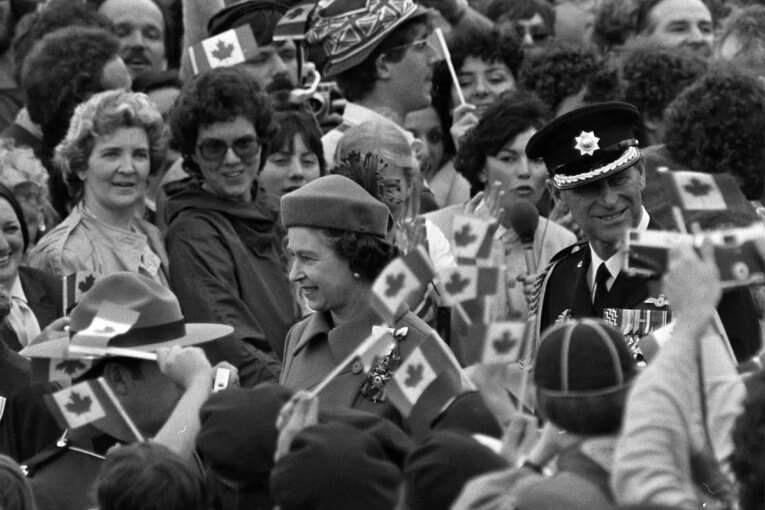
She cried at the beginning, when it was finally real. She was 25 years old — an accidental princess, daughter of an accidental king, heiress, all of a sudden, in a Kenyan hunting camp, to a crumbling empire, new symbol of a fading world.
But for Elizabeth, by the Grace of God, Queen of the United Kingdom of Great Britain and Northern Ireland and of Her other Realms and Territories, the tears didn’t last. Not in public anyway. By the time reporters saw her again that day, the day her father died, the day she became Queen — Feb. 6, 1952 — she was, in the words of a journalist on the ground, “composed.”
“She took it,” a staffer told the reporter, “like a Queen.”
For almost 71 years, through scandal and heartbreak, through national decline and local humiliation, Elizabeth II, Queen of, among other territories, Canada, kept it together for the cameras. She was, by the end, a living symbol, if nothing else, of endurance, of the ability to keep going, to put on a brave face.
She was the only Queen most alive in the Commonwealth ever knew. She was the closest living relative of George Washington, a direct descendant of German and Russian emperors, Danish, Norwegian and Prussian kings, the inheritor of a royal line in England that dated back to Egbert of Wessex, in 802 CE (a line that included, among other ups and downs, Egbert’s unfortunate great, great grandson, Æthelred the Unready.)
And yet, to say, as many have in recent days, that she bridged eras doesn’t quite capture the reality of who she was. It is true that Queen Elizabeth II, who died Thursday, was a symbol of a long, fraught and often bloody history in England, Great Britain and all over the world. Her father was the last Emperor of India, and the last English king of what is now the Republic of Ireland.
She herself oversaw, as Sovereign, the last, sometimes brutal, gasps of colonial rule in most of Britain’s African colonies. She was the Queen of Bloody Sunday in Derry, of the dirty war in Kenya. She wore as a royal symbol a huge diamond acquired from colonial South Africa and another, in her crown, from the Indian Raj.
She didn’t stand astride history, then, linked to it though she was. She didn’t exist in the past. She was instead a living anachronism in a real world: a human myth forced to rub up uncomfortably, through all her days, against the painfully real.
And yet, for all of that, beneath the symbol, buried deep perhaps, there was a person, too. It is impossible now to judge Elizabeth’s reign as Queen. She didn’t rule anything in practical terms. And what she oversaw in her name was too vast and too complicated for simple judgment here. But at some level at least, it is possible to consider the person who sat on the throne, to examine the human who gave away so little, for so long, and yet at times seemed to offered so much meaning to some.
She wasn’t born to it, is the thing. It was never supposed to be hers. She was a royal, but not the heir, not at first. She didn’t grow up in the palace. She spent her early years in a home on Piccadilly, near St. James Square. (When her nanny told her she was to move to the palace, she is said to have replied ‘What? You mean forever?’ ”)
Even when her uncle, Edward VIII, abandoned the crown in 1936, it wasn’t obvious that Elizabeth would one day be Queen. Her father, George VI, was only 40 when he took the throne. He already had two daughters, but still had plenty of time, many believed, to produce a son.
He didn’t, of course, and when he died in 1952, Elizabeth became Queen. What’s striking, looking back now, is how much of the coverage of Elizabeth’s ascension seemed touched with pity. It wasn’t so much that she had lost her father. It was that “the pale girl in black,” as one story dubbed her, was now stuck with being Queen.
“On the morning the King died, people gathered in groups everywhere to talk of his tragically unexpected death,” The New Yorker wrote at the time, “and then immediately of Elizabeth, without altering the tone of their voices, as though she, too, had been struck down by some grave illness — the malady of sovereignty, which lasts a lifetime.”
King George VI was buried on Feb. 15, 1952. In the lead-up to the funeral, it was already clear that Elizabeth faced an impossible balance as Queen. “She must ride through miles of curious crowds in her carriage behind the King’s body showing the proper degree of sadness and at the same time presenting a regal aspect, lest her new subjects judge her and find her wanting in either queenly dignity or seemly sorrow at her bereavement,” The New York Times wrote the day before the event.
That conundrum would, in many ways, go on to define the next 70 years of her life. She had no power that wasn’t symbolic, and the symbol she chose more than any other was the stiff upper lip. In 1969, she refused to attend the funeral of former U.S. president Dwight Eisenhower because, in the logic of a royal source who spoke to the Times, that kind of thing just wasn’t done. (By tradition, the sovereign only attends the funerals of direct relatives, although Elizabeth did bend that rule for Winston Churchill.)
Her stoicism by turns impressed and baffled her subjects. “She could write a passionate four-page letter to a friend in response to a brief commiseration about the violent death of a favorite corgi,” Martin Amis once wrote of the Queen. “ But when, in 1966, a hill of slag collapsed on a village in South Wales, Aberfan, killing a hundred and sixteen children (and twenty-eight adults), the Queen, against all advice and family precedent, delayed her visit for more than a week.”
Her public reserve saw her through the blooming personal scandals of her family in the 1980s and ’90s. It brought her low after Princess Diana’s death, when she was judged to have shown insufficient public emotion. It made her shine, as a nonagenarian, during the COVID pandemic, when her public statements of togetherness and strength exuded a calm confidence absent from so many during those frightening first years.
Her silence in later years seemed at times deliberately, even irresponsibly, withholding. She stayed quiet when her son, Prince Andrew, was accused of sexually assaulting a teenager. She never spoke publicly about the rift between the family and her grandson, Prince Harry, and his wife Meghan, the first Black person to ever marry into the royal line.
And yet, because she showed so little emotion, for so long, it became all the more meaningful when she did. After the attacks of Sept. 11, she wrote a letter to the people of New York that betrayed an unusually personal sorrow.
“(N)othing that can be said can begin to take away the anguish and the pain of these moments,” she wrote. “Grief is the price we pay for love.”
She was also a person who knew that sometimes, there are simply no words that will do.
The humanitarian and surgeon David Nott met the Queen not long after returning from Aleppo during the civil war. When she asked him about the experience, he later recalled in his own diaries, and in a story by The New Yorker’s Ben Taub, he started to break down. The Queen, he wrote, motioned to a servant, who indicated a silver tin sitting nearby. The Queen took out a biscuit, broke it in two and offered a half to Nott. “These are for the dogs,” she said.
For the rest of the meal, the two fed the corgis at their feet. “All the while we were stroking and petting them, and my anxiety and stress drained away,” Nott wrote. “There,” the Queen said, according to Nott. “That’s so much better than talking, isn’t it.”
You can read more of the news on source



